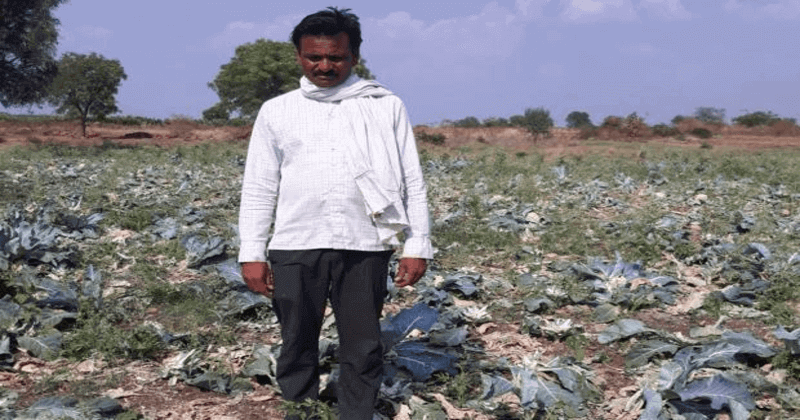
A farmer’s livelihood is, naturally his hard earned crops. So no one in their right minds will destroy it.
So why did this farmer destroy his?
Premsingh Lakhiram Chavan, 42, a marginal farmer from Jalna district in Maharashtra, pinned his hopes on a small vegetable plot where he grew tomatoes and cauliflower. Some months back, Chavan’s cotton crop was destroyed by the notorious bollworm pest.
On 10 March, Chavan took four quintals of freshly harvested tomatoes to a nearby wholesale market. All he got was Rs442, less than the Rs600 spent just on transporting the produce and paying for the gunny bags. And nowhere near the Rs 25,000 he’d spent on nurturing the crop.
Distraught and angry, he returned to his farm, picked up his hoe and set upon the ready-to-harvest crop of cauliflower until it was completely destroyed. The popular vegetable would not fetch him more than a rupee a kilo, he knew.
On Monday, a disturbing video of Chavan, shot by another farmer, appeared on various social media groups showing him razing his crop.
Here is the VIDEO uploaded by Time of India news channel:
Chavan thrashes the cauliflower ruthlessly with a hoe, anger as well as helplessness writ large on his face, cursing the government for looking the other way as he suffered.
The visuals mirror the anguish among farmers—small and large—across India, hit by an unprecedented collapse in commodity prices over the past two years. The price crash follows consecutive years of record production of grains, pulses and vegetables in 2016 and 2017.
Chavan’s outburst came around the same time when Maharashtra’s capital city witnessed a massive gathering of farmers on 12 March—demanding better crop prices, land rights and loan waivers. Many of these poverty-stricken farmers walked in torn shoes, and the soles of their feet bled from the 200-km march from Nashik that took a week to complete.
The Mumbai protests also marked close to a year of farmer protests in states like Maharashtra, Gujarat, Rajasthan, Karnataka, Haryana and Punjab. The beginning, in June last year, was grim—at least five farmers were killed in police firing in Madhya Pradesh.
“I can no longer run the daily expenses including the small amount I have to pay for my son’s education every month,” Chavan told a leading daily newspaper over phone on Tuesday afternoon.
His many complaints include the fact that his Rs 90,000 debt is yet to be written off despite the Maharashtra government’s ongoing farm loan waiver scheme. It beats him how a farmer can afford to keep incurring expenses to grow crops and get virtually nothing in return.
“On that day I was angry and did not know what to do… I am ashamed that I am a farmer who is becoming poorer by the day,” said Chavan, who belongs to the Marathwada region of Maharashtra, a hotbed of farmer suicides.
The low prices responsible for Chavan’s plight, however, are not benefiting consumers. In Delhi, on Monday tomatoes sold for Rs20 per kg in retail, more than ten times the price Chavan got at the farm gate.
One reason for the price discrepancy is that India’s agriculture markets continue to be fragmented, with barriers imposed by state governments that prevent the entry of new traders who can use the arbitrage opportunity to make profits, helping drive wholesale prices up for growers, and retail prices down for consumers.
Despite efforts by the centre, including a new model law on marketing, India is still a long way from a unified national market.
Indian farmers have other questions too. “I have heard that if my tomatoes can be made into sauce (ketchup or puree) I can get better price,” Chavan says. He is referring to food processing and value addition for the farmer, a potential revenue stream—potato chips are a good example—that has eluded most farmers so far.

Post Your Comments